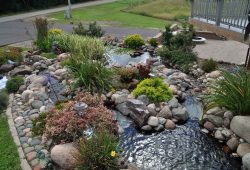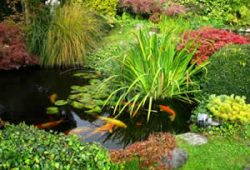Koi Pond Maintenance
Here Is Information Over Koi Pond Maintenance That You’ll Want To Take Note Of.
Through the Seasons
The four seasons provide timely stages to bolster the maintenance of a perfect pond.
Spring
Koi require clear water to thrive and remain healthy. Water quality will often appear to be at its best in spring but debris from falling leaves and dying plants may be in the water following the fall and winter seasons, which will increase the algae content and potential risk to the koi from harmful bacteria if not dealt with.
This is one of the reasons why an annual clean of the pond is best done in spring. The other reason is this provides the pond with its best opportunity during the summer to redevelop.
The water should have a PH value of 8 at the start of spring. Water treatment additives to help bolster the strength of koi to fight infection following their winter lethargy should be considered in spring.
Summer
Higher temperatures in summer reduce the level of oxygen in the water of the pond. One sign of reducing oxygen level is the koi seeming to gasp near the surface of the water.
Oxygen levels can be increased by adding water features to move the water or changing the water itself. Higher heat may cause some water to evaporate. If changing the water or adding to it, dechlorinated water must be used.
Summer is the season when parasites are at their most active so the keeper should be alert to signs of illness in the koi fish. The signs could be spots or changes in colour or the fish behaving abnormally such as trying to scratch against rocks, etc. In either case, it may be necessary to seek professional advice.
Feeding koi with higher levels of nutrient but low levels of protein is recommended in summer.
Fall
Plants will be shedding leaves and generally receding in the fall. Most of the fall season should include daily clearing of leaves and other debris from the pond surface and removal of any potential new debris from foliage in the vicinity of the pond.
Depending on temperature and weather, turning any water features off after the summer may be advisable to lower the amount of water that may require heating in the colder weather to come.
Winter
Koi activity will be very much slowed down in the winter, so less food will be required.
Cold winter weather brings the risk of pond water freezing, which is dangerous to the koi though they will survive generally colder temperatures for periods of time.
A heater might be required, the power of which will be determined by the size of the pond and the volume of water it contains.
If the weather becomes very cold, it might be necessary to house the fish in indoor tanks for such emergencies.




